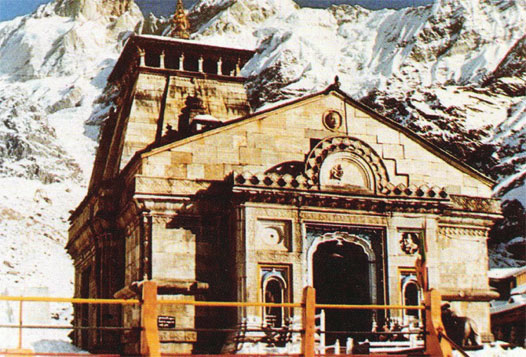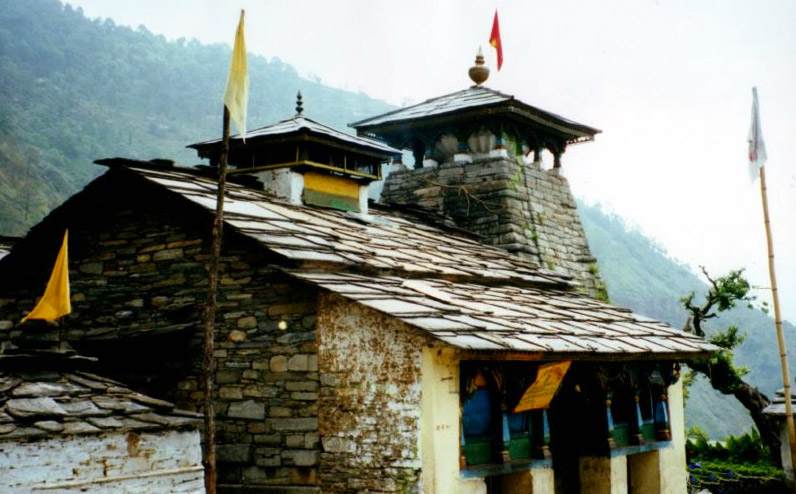 |
|||||||||||
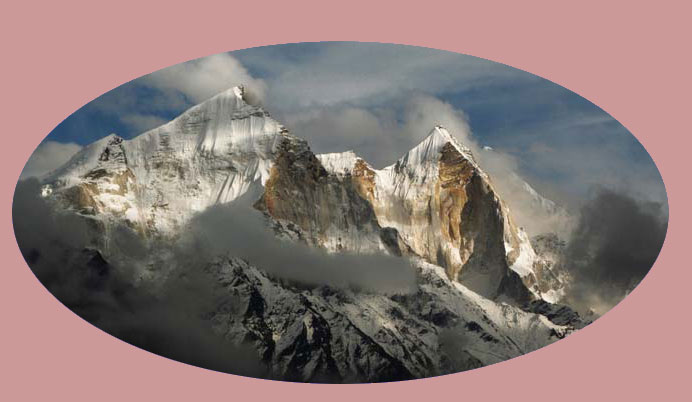 Bhagirathi |
|||||||||||
Namashivaaya Panch Kedars The Five Kedars The Mahabharata is one
of the oldest epics in the world and was written by the sage Vyasa.
There is no subject on which it doesn’t deal with. However all the
various subjects are woven into the story of the Kuru dynasty which
ruled over India about five thousand years ago. Modern Delhi is built
over their capital city of Indraprastha. The epic deals with the
rivalry between the cousins known collectively as the Pandavas and the
Kauravas. It ends in the internecine war between the two factions. The
Pandavas were five in number and are said to be the sons of the gods in
as much as they were all extremely noble. Arjuna, the hero of the epic
and the middle one amongst the Pandavas is the one to whom Lord Krishna
gave the discourse of the Srimad Bhagavad Gita. This discourse comes in
the middle portion
of the Mahabharata and deals with the human problem
– how to attain liberation from the coils of material life. However it
also deals with the very practical aspect of how to deal with our
day-to-day life.
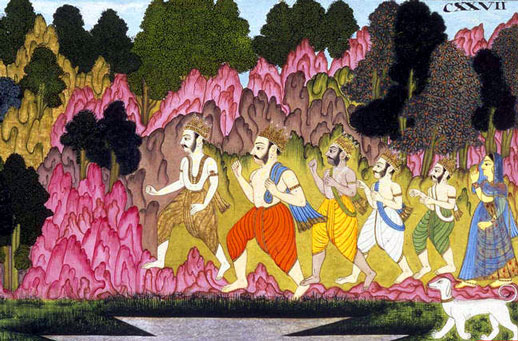 Pandavas with dog Dharma At the end of their life, the Pandavas decided to give up their kingdom and go to the Himalayas and meditate on their favourite deity, Lord Shiva. So they set out accompanied by their wife, Draupadi. When they reached the place called Rudraprayag, they thought they had a glimpse of Lord Shiva. They tried to chase him but he took on the form of a buffalo and dashed off towards the north. They followed in hot pursuit and eventually caught up with him at the place that is now known as Kedarnath. The Lord now dived into the earth. Only the hind portion of the buffalo was sticking out. This was caught by one of the brothers called, Bhima. But pull as he might, he couldn’t get the rest of the buffalo out of the ground. The hump now turned into a Shiva Lingam and remained at this place. Each of the other parts appeared at four other places and came to be collectively known as the Panch Kedars or the five Kedars. All these lie in the Garwal Himalayas in the modern state known as Uttranchal. 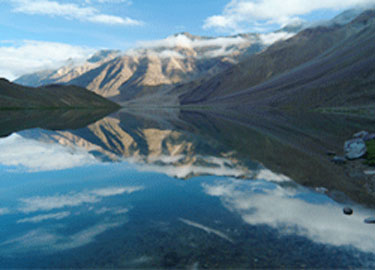 Rudraprayag The Garwal Himalayas lie to the north east of the Indian peninsula and is known as the Valley of the Gods. The air is fragrant with the aroma of spirituality. When one gazes at the snow clad peaks and hear the gurgling of the Ganga as she jumps over boulders and rocks and watch the mists rise up from the rivers and valleys one can easily believe that this is indeed the playground of the devas. (Gods). This is the place where countless sages have meditated and become enlightened and the very air is fragrant with the perfume of their amazing vibrations that have lasted through the centuries. The Himalayas are filled with the power and passion of Lord Shiva and in this part of India, we find more shrines to this deity than to any other. The most famous of them is the temple of Kedarnath. Cradled in the bosom of the Himalayan ranges there are four other temples, which along with Kedarnath that go under the name of the Panch Kedars or the five Kedars. They are situated in inaccessible places and provide a challenge to any devotee of Shiva who wishes to worship him in places that are far away from the madding crowd. Shiva is noted for his love of lonely peaks and solitary ranges. His true worshippers should always be prepared to take the leap into the unknown and face all the challenges that he places in their way, as the Pandavas did. Those intrepid ones who actually dare to go to these places will find that they are amply rewarded for their determination and devotion. The air is saturated with Shiva Shakti and one can easily imagine him striding across mountain crags and peaks, his matted hair mingling with the clouds and snakes twirling around his neck! These five temples are sprawled all over the vast Kedar valley at altitudes ranging from 1500 m. to 3680 m. Out of these Tunganath is the highest at 3,810 m, Kedarnath is 3584 m., Madmaheswar is 3289 m., Rudranath is 2286 m. and Kalpeshwar, 2134 m. |
|||||||||||
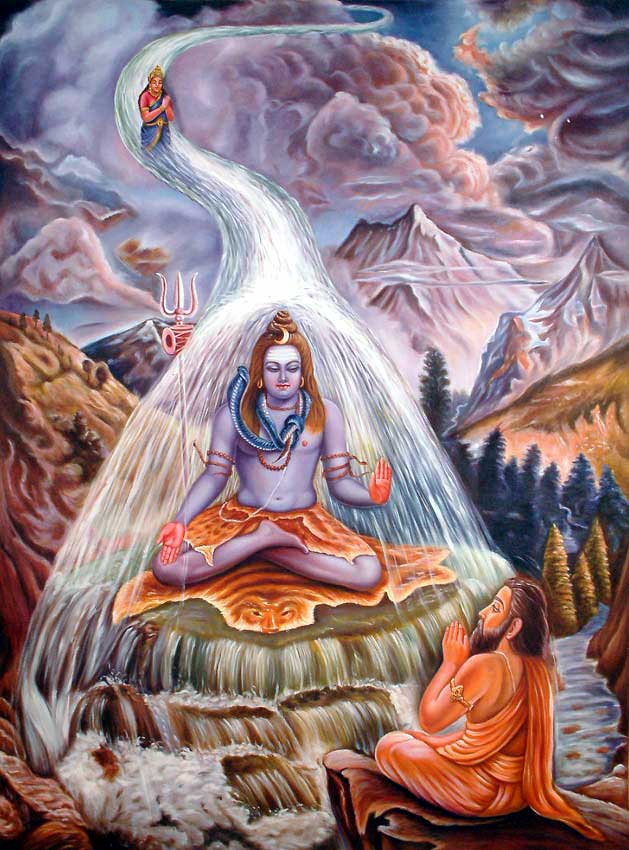 Descent of Ganga at Bhagirathi Painting Thanks to Exotic India Art |
|||||||||||
KEDARNATH Of these Kedarnath is the biggest of the temples and the most popular. The Shiva Lingam (sign of Shiva) here is a natural rock in the shape of a buffalo’s hump. Rudranath is the place where his face appeared, Madmaheswar is where his navel is said to have fallen, his arms appeared at Tunganath and his tresses at Kalpeshwar. 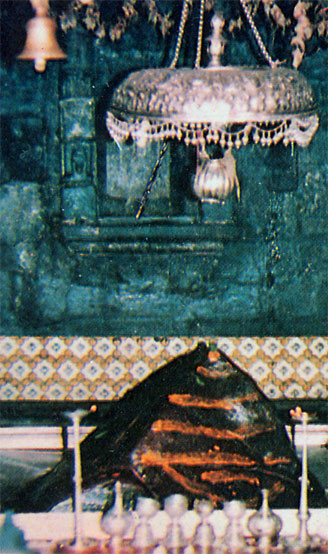 Kedarnath Lingam Kedarnath is situated at the head of the Mandakini River. It is at an altitude of 3,584 m. with a breathtaking view of the snow capped Himalayas in the background. The temple is made out of huge granite slabs. Adi Shankaracharya, the founder of the Advaita philosophy is supposed to have worshipped here and fixed the method of puja. With his usual foresight, he made a rule that the pujaris (priests) of this temple should be brought from the state of Karnataka in the south and the priests of Garwal should go to the Shiva temple of Rameshwaram in the south. This is the custom up to this day. The journey to Kedarnath starts from the pilgrim town of Rishikesh at the foothills of the Himalayas. The railway track ends in Rishikesh. From here one can take a car or bus and go up to Rudraprayag. This is a famous confluence of two rivers where the River Mandakini, which comes from Kedarnath, meets the River Alagananda, which comes from Badrinath. From here one has to take the route to the place called Gaurikund, which is as far as the motorable road goes. This place, which is dedicated to the goddess Gauri, the consort of Shiva, has a beautiful hot water spring in which all pilgrims are supposed to take a bath. There is a lovely shrine to the goddess close to the spring. The 14 km. trek to Kedarnath begins from Gaurikund. Those who find it difficult to walk can take ponies and old people can be carried in something called a doli, which is a kind of hammock, carried by four people. En route we come to a halting place called Rambara. The track is made out of cobbled stones and is quite difficult to walk on. But the problems of the trek are forgotten when we gaze at the breathtaking vistas that open out before our astounded eyes at every turn. All through we are followed by the gurgling sound of the Mandakini as she rushes down the deep gorges and valleys. Actually most of the fascination of the route is spoilt for the earnest pilgrim who goes on foot, by the ponies that come behind and threaten to nudge him off the cliff. The track clings to the hillside that overlooks valleys that are more than 500 km deep so the prospect of being nudged off these cliffs is not such a happy one.
Kedarnath Temple However our first view of the temple as we come up is enough to take away all the fatigue of the journey. The fantastic snow mountain at the back sets off the stark granite structure of the shrine. You literally give a gasp of delight when you see this view. Unfortunately the approach road is now filled with modern restaurants and shops so part of the charm is lost. Hindu pilgrims are always required to take a bath before they enter any temple. There is no hot spring here as there is at Badrinath so one has to take a bath in the icy waters of the Mandakini. However in the past few years two and three-star hotels have sprung up so hot and cold showers are available in the bathrooms. I always feel that comforts are always at the cost of sanctity - the more the comforts, the less the sanctity! Another problem is that the more the comforts, the more the pilgrims who behave more like tourists than true pilgrims. A special feeling is generated when one dips in the freezing waters and stays in an ill-ventilated, tiny room and runs to the temple at the crack of dawn to be present for the first puja. Unlike Vishnu temples where the devotee is not allowed into the sanctum sanctorum, in Shiva temples you can go right up to the lingam and do one’s own abhishekam (ritual powering of water over the idol) as well as touch the idol. This is a great thrill for everybody. The pujari (priest) is there and will also do a puja for you if you so wish. In fact there are many pujas during the course of the day in which you can participate. The lingam is a huge hump-shaped rock that is anointed and decorated very beautifully. Shiva is supposed to be “abhisheka priya” (one who loves to have water poured over him) while Vishnu is said to be “alankaara priya” (one who loves to be beautifully dressed), so you will find that Shiva Lingams are never as beautifully decorated as the idols of Vishnu. 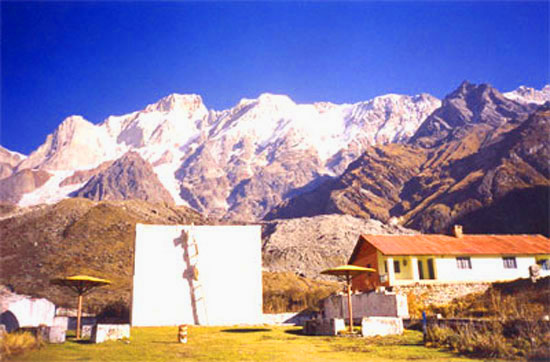 Samadhi of Adi Shankaracharya at Kedarnath Two other spots worth visiting here are the samadhi of Adi Shankaracharya and the Gandhi Sarovar. There is a lot of debate about the place where Adi Shankaracharya actually passed away. One faction claims that it was at Kedarnath so there is a shrine here to this most renowned teacher of the Advaita philosophy, which is the philosophy of non-duality. Gandhi Sarovar is a glacial lake in which some of the ashes of Mahatma Gandhi were scattered. Of course there are many other beautiful treks in and around the place which one can do if there is time and inclination. The return journey is also to be covered in one day. There is a short stop at Rambara and then on to Gaurikund where one has to stay the night and then proceed to the next shrine known as Madmaheswar. |
|||||||||||
| MADMAHESWAR A pilgrimage to the Himalayan shrines can be undertaken only by those who are not haunted by the spectre of Time looming behind them with the proverbial scythe. To these adventurous types, the Himalayan shrines offers a vast storehouse of not mere spiritual merit but also a feeling of profound fullness and satisfaction on all levels of the personality – physical, mental and aesthetic. Madmaheswar is situated at the foot of the Chaukamba Peak at an altitude of 3,500m. This is the place where Shiva’s navel is supposed to have emerged. After finishing our Kedar trek we have to return to Gaurikund for the night halt. From here one can take a vehicle to Guptakashi. Kashi is the old name for Varanasi and “gupta” means secret or hidden. Guptakashi has an ancient temple of Shiva and derives its name from the fact that this is the place where Shiva is supposed to have hidden himself when the Pandavas chased him. At this place he disappeared and hid himself in a cave. Hence this place is known as Guptakashi or the “hidden Kashi”. 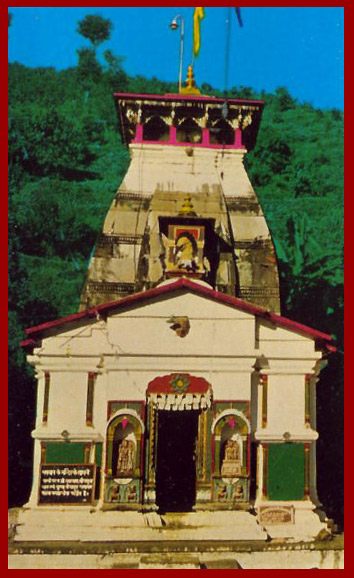 GuptaKashi Temple Those who are keen on a longer trek like us can get off the bus or car at a place called Devidhar from where there is a delightful forest track up to Kalimath, which is our first halting place. The three kilometer walk took us through a thickly wooded slope carpeted with the leaves of pines and deodars, which are centuries old and which muffle our footsteps. This track leads to the stream called Kali. From here the track winds up to the tiny village in which is situated the temple of Kali Mata or the Goddess Kali. The temple is open on all sides and is surrounded by striking red wooden pillars. It is a siddha peeth in which one of the parts of the Goddess Sati is supposed to have fallen. Siddha peeths are said to have the ability to fulfill all our wishes. Legend goes that the Goddess Chandi Devi was sitting on a rock, combing her hair when two demons that were the servitors of the two brothers Shumba and Nishumba saw her and were totally captivated by her intoxicating beauty. They ran back to their masters and reported the matter to them. The whole story is narrated in the Devi Mahatmyam. The rock on which she was sitting is close to this temple. After an overnight stay at Kali Math the trek continued along an undulated terrain with thickly terraced slopes. The river known as the Madmaheswar Ganga could be seen far below, glinting and sparkling in the sunlight. Seven kilometers from Kali Math we reached the little hamlet known as Raun Lek where we stayed at a humble homestead. We had decided not to be hustled on our journey but to go slowly and thus enjoy the scenic beauty and the feel of the land by staying with the peasants. The little room that they gave us was not as clean as one would have liked but the cobbled terrace where they gave us dinner had a breathtaking view of the entire valley with the roar of the river thrown in for extra measure. In the distance was the magnificent Chaukamba peak on which the setting sun was giving special light effects. No five star hotel could ever boast of such idyllic surroundings. The long Himalayan twilight drifted into an enchanted night with a sky, studded with huge stars hanging low over our heads! This was not a five-star hotel but a million-star one! Very soon the eighth-day moon came out to enhance the beauty of the scene. We sat on the terrace and soaked in the atmosphere while our host regaled us with surprising bits of information coming from one living in such a remote spot. He also told us of an alternate route from Gaundhar which could be reached by taxi from Guptakashi. Of course this route would totally cut out the beautiful temple of Kali Mata. 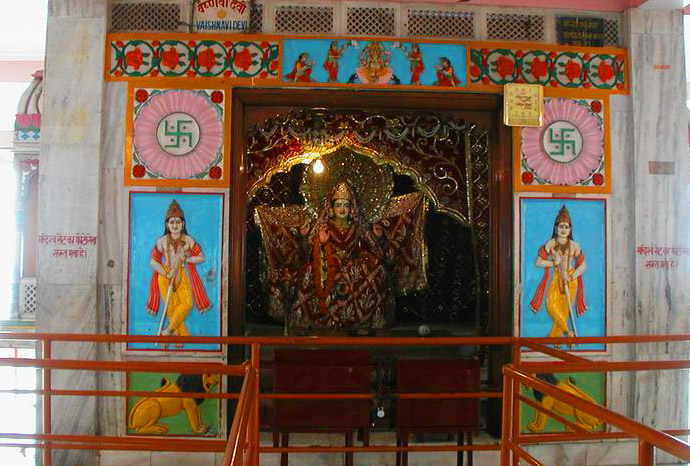 Chandi Devi Temple It is always good to set out as early as possible when you are trekking in the hills. In summer the day gets light by 4.30am and we covered the 8 kilometers to Ransi in a fairly short time since the terrain was not hilly. Here there was an ancient temple to the Goddess Rakheswari and we rested a while in the dim recesses of this temple, enfolded in the benign waves emanating from the goddess. Our night halt was at Gaundhar so we set out as fast as possible. The walk to Gaundhar was really charming. The track winds up for a while and then started going down through pine forests. Many a turn in the path brought us face to face with fantastic waterfalls and secret pools. Wild strawberries nestled in clusters of dark green leaves. We didn’t have time to gather them but just then a “pahari” (hill) belle approached us and thrust some of the delicious berries into our hands. What could we offer in exchange for this manna from the gods? Sacrilegious to think of giving biscuits and artificially flavoured sweets. The priest at Ransi had warned us not to stay at Gaundhar, which is where all pilgrims halt, but to push on another 1 kilometer to Vantoli, which is actually the base camp for the ascent to Madmaheswar. This spot was one of the most charming we had ever stayed so far. There is a confluence of two rivers here and the tiny homestead where we halted nestles in the lap of a vale with towering peaks on one side and the roar of the waters as they rush to meet each other at the confluence. We had an exhilarating bath in the icy waters, clinging on to a branch of a tree for fear of being swept away by the current. After this we were ravenous. Never had we eaten such a delicious meal. Just plain chapattis with some green leaves that the little boy ran and plucked from the adjoining fields and some thick curds. The milk and curds in these hills are really wonderful – thick and creamy from cows fed on green grass and leaves alone. Potatoes were a luxury since that year’s crop had not been harvested and most of them were too poor to go to the nearest town to buy such “luxuries”! Magic moments when we wandered along the river and sat on sun-bleached rocks, sprinkled with the icy spray from the foaming, swirling, dancing waters around. I wonder if any sophisticated mountain resort could compare with this pristine beauty!
Ransi The next day was the last and most difficult part of our journey. We had to do nine kilometers of really stiff climbing with only one hamlet in between where we might get some refreshments. The track wound its way through shady pine-clad slopes to the hamlet. After a short break we commenced the hard climb, sometimes through forests and sometimes over bare slopes. The river was only a silver streak far down below from which the wind wafted the faint sounds of the roaring waters which had turned into a whisper. Even though it was a hard climb, the sight of the pink and red rhododendron flowers encouraged us to push on. Creepers trailed their vines across our tired faces as if to comfort us. We had been warned to be on the look out for bears but nary a one did we ever see! However we did see a couple of playful creatures resembling back and white badgers who were not in the least bit put out by this invasion of their privacy. One of the nicest things about this trip compared to the one to Kedar was the fact that we didn’t have to jostle our way between frisky mules and coolies carrying people on their backs in baskets! Due to its inaccessibility Madmaheswar is off the beaten track for most rich pilgrims and the poor ones cannot afford ponies and baskets! We felt as if the whole world belonged to us alone. The only sound to assail our ears was the mournful screech of the Himalayan eagle and the muted murmur of the waters below. But this final assault was really arduous. The nine kilometers took seven hours. At last when we had almost given up hope of reaching our destination before the sun set, a turn in the track gave us a breathtaking view of the valley, with flower-studded slopes and a gushing stream meandering across it. The towering peak of the Chaukamba formed the backdrop and the tiny temple nestled at its foot looking as if it was a painted canvas. Another ten minutes brought us right up to the temple where the priest and a swami were basking on a rock in front of the shrine trying to catch the last rays of the precious sun. The priest was a young man hailing from the southern state of Karnataka. He informed us that the four priests of the Shiva temples of Kedar, Madmaheswar, Ukhimath and Guptakashi came from Karnataka as decreed by Adi Shankaracharya and every year, they kept rotating between these temples. The temple is a replica of the Kedar temple but on a miniature scale. There are only two pujas here, one at 8 am and an evening arati at 7 pm. The priest kindly invited us to lunch with him since the only shop which the place possessed was closed since the proprietor had gone down to procure provisions. Luckily he was right behind us and arrived with a great haul of atta (wheat flour) and lentils. We were invited to wash ourselves in the little spring that seemed to gush out from beneath the root of a gnarled tree. We rested in the accommodation provided by the temple authorities, which was luxurious compared to the huts we had stayed in. We explored the beautiful surroundings till the tinkle of the temple bells summoned us for the evening arati. Inside the sanctum was a beautifully decorated lingam, which seemed to shine with a radiance of its own. The lingam was the middle portion of Shiva and was encased in a silver covering with the inevitable snake emblem above it. The exquisite puja articles were all made of silver and were exact replicas of the ones at Kedar. The arati was a prolonged affair with much clanging of gongs and bells by the shopkeeper’s children. The two small shrines outside contained priceless carvings of Shiva and Parvati in a most unusual pose and another of the goddess, Mahishasuramardini, the slayer of the demon- Mahishasura. The former was similar to the one we had seen in Kali math but the latter was unique. After the puja was over we retired to our exclusive hotel for our humble fare of chapattis and dal with a few boiled potatoes thrown in. These had been dug out by the shopkeeper’s son from the hard earth. It was the left over of last year’s crop. Then we went to the priest’s room to listen to his interesting tales of adventures in the hills. 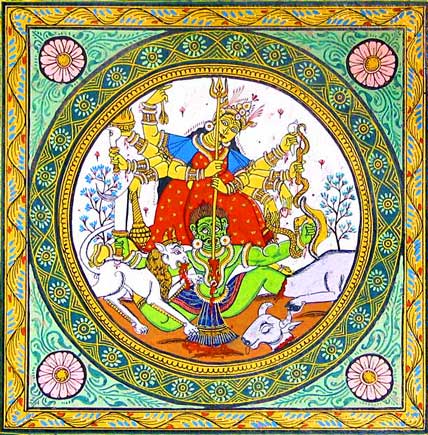 Mahishasuramardini He told us the history of the temple. One of the ancient kings of that region was annoyed to find that one of his prize mulch cows always came back dry. Determined to find out the reason for this, the king followed the cow and saw her shedding her milk over a stone at this spot. The irate king brought his sword down on the innocent cow’s head but the blow missed its mark and fell on the stone, which started to bleed. The king cleared the grass from round it and discovered that it was a lingam. Even today the mark of the sword is seen on top of the lingam. The remorseful king atoned for his sin by building a temple round the lingam. He died before he could complete it and later on someone else completed it. One of the stones on the right side gives some information about the date and name of the person who completed it but the priest said that though the archeologists had made a through study of it no one had been able to decipher it. However the method of the rituals to be conducted here as in all the Himalayan shrines had been augmented by Adi Shankaracharya, the master trekker of all times. He is supposed to have covered all this terrain on foot and laid down the rules and regulations concerning the type of worship to be offered at all places. By decreeing that the priests of the Himalayan shrines should come from the south and those at Rameswaram in the south, should come from the Himalayas, he saw to it that there was a good intermingling of the cultures of the north and south. Next morning bright and early we trekked up to the highest point in that place to the temple of Buddha Madmaheswar. The hills were really alive with the sound of divine music as we clambered up the grassy slopes dotted wildly with myriads of white and yellow flowers with little clusters of red here and there and violets behind mossy stones. Walking in the shadow of these majestic snow peaks we feared to tread hard for fear of defiling this holy spot. Who knew what treasures lay beneath the unwary foot that carelessly crushed a million tiny sparkling flowers? Here the rhododendrons had been reduced to dwarf size and hung in clusters of waxy, mauve flowers which dropped unheeded on to the grassy carpet - an unceasing offering to the great Lord -Mahadeva (Shiva). 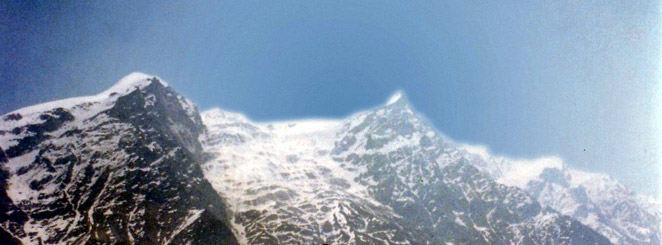 Chaukamba Devi The whole valley was rolled out like a carpet below us with an unhampered view right up to Raum Lek. On one side towered the glittering, spectacular peak of Chaukamba Devi; home of eternal snows that had been inspiring us all through our trek. Now it appeared as if it was only a short distance away, spotlighted by the rays of the early morning sun. Impossible to describe the beauty of that scene with the valley below and the snow peaks all around. All the peaks were mirrored in the glacial lake below giving the amazing impression of a double exposure. Glacial lakes are perfectly still and mirror the surroundings with absolute accuracy. We threw ourselves on the velvety grass and imbibed the fragrance of that perfumed air. Words are poor instruments and hardly likely to do justice to the exquisite charm of that blissful spot. Even photographs could only give a faint idea. We had to tear ourselves away from this sanctified spot and come down for the puja at 8 o’clock. The silver covering of the lingam was removed and saw the cleft on the crown. Unlike other Shiva temples in the north, the devotees are not allowed to enter the sanctum and do the abhishekam. We could only observe from the adjoining room. The villagers around donated the flowers, rice and other offerings for puja. These villages were far below the temple but to these hardy hill tribes a walk of five or six kilometers with an ascent of a thousand meters was nothing. Every morning one of the villagers would come with the daily offering. They would wait for the prasadam that was distributed after the puja. By god’s grace we were not pressed for time and we spent a couple of days in this idyllic spot roaming round the mountains, watching the sunset and sunrise and generally saturating ourselves in this divine atmosphere so that it would remain an indelible memory for us. What can be said about the journey back to the twentieth century. It took half the time according to our watches but over two centuries as far as culture was concerned. Back to a world of roaring, tearing traffic, jostling crowds, noise and screech of vehicles and people rushing madly all the time not knowing that they were getting nowhere – back to a world of chips and cheese and chay (tea) from which we had escaped for a few glorious, enchanted days! 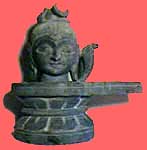 Namashivaya! |
|||||||||||
 If there is one thing that the Himalayas teaches you it is that one should have absolute faith in God alone. Nothing and nobody can help you in those high reaches except the almighty. Without this faith and total surrender there is not much point in doing these treks. The value of the trek doesn’t lie in reaching the place but in the effort of getting there. Each step and each vista can either be a dream or a scream depending on your metal preparation. After having done Madmaheswar we thought that Rudranath would be quite easy but of course even though Madmaheswar is actually a longer trek, there are villages en route where we can take rest as well as get some sort of sustenance. Here there was nothing. We had absolutely no idea what we were letting ourselves in for and had not thought of carrying any food with us. All we had was water and a packet of biscuits. On top of which we had decided not to take either a porter or a guide as most people do. We were sure that our belief in God alone would get us to the temple. The only guide we wanted was Sri Rudranath himself! 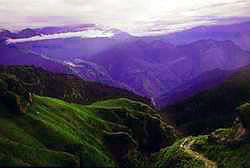 The trek to Rudranath starts from the village of Sagar. For this one has to go to the town of Gopeshwar and get a jeep from there to Sagar, which is 6 km away. From Sagar to Rudranath is a tough 22 km. trek that has to be done in one day since there are no villages en route where one can take shelter. However we were travelling on the proverbial shoestring and had just invested in modern backpacks with a lot of facilities so we dared to do it without any porter or guide. An hour after we started we came to a dense forest with absolutely no trails. It was a unusually thick and we just kept climbing without much idea of where we were going. It is one of the most exciting things in the world to walk in a trackless silent forest, with only the steady tramp of our feet and a few birdcalls from here and there. Now and again a fallen tree trunk blocks your way. They look like souls who are prostrating to the divine in absolute surrender. Sometimes golden rods of sunshine fall through the chinks in the canopy above and stroke our faces with love and warmth. I just love that feeling of total dependence on divine providence alone. My poor son and brother were burdened with their backpacks so maybe they didn’t quite have the same feeling as I did. We had hardly walked a couple of hours when the sky became overcast and rumbling sounds could be heard. Soon it started drizzling and then it came pouring down. Had we been in the open we would have been totally drenched but thanks to the dense canopy above us we didn’t get soaked. We had come with some plastic sheets and raincoats so we covered the packs with the sheets and huddled together under our raincoats. We thought it better to wait till the weather cleared a bit before proceeding. We were also famished after the two-hour walk so the biscuits finished in a trice. Just then it was nothing short of a miracle, but we heard the sound of tramping feet behind us and who should appear but a Squadron Leader of the Indian Air Force accompanied by his team of men who were doing the Panch Kedar trek. Of course they were loaded with food and tents and all types of modern equipments, which made trekking easy. They gave us all encouragement and told us that they would meet us on the plateau, which was an hour away. They had brought packed lunches and we were welcome to join them. My eyes filled with tears when I thought of the grace of God who had sent a whole squadron from the Indian Air Force to help us despite the fact that we were so foolish as to go without any food! 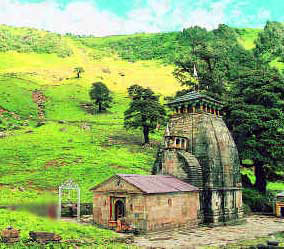 Madmaheswar Temple By this time the rain was letting up so we also started trekking with added vigour. When we reached the bugyal or meadow they had already set up a small cooking unit and gave us a welcome cup of tea as soon as we arrived. The view from there was really something. It was truly incredible. The meadow was dotted with wild flowers and down below the valley stretched out with the sides carpeted with tiny flowers. We still had a long way to our destination and we knew that we would have to start walking if we wanted to reach before sunset. So we reluctantly refused their offer of lunch but did take some sandwiches that they had packed and kept ready. By this time the sun was up so it was a real delight to climb up those grassy slopes with hardly any tracks except those made by goats and shepherds. Since I was very slow my companions were soon well ahead of me. This was really what I wanted since I love the sense of being all alone on the hillside with only the sounds of the insects, the occasional ripple of streams in the distance and the brilliant sunlight. Suddenly a host of butterflies, which had just come out of their cocoons, rose up before me like a cloud. They were all bright yellow and it almost seemed as if the flowers had suddenly decided that they had enough of being tied down to their stems and wanted to experience the joy of flying in the air! Now and again I would see a clump of wild strawberries, small and bright red, nestling in their cluster of dark green leaves. The sky above was the peculiar intense blue, which is found only in the mountains. Not a cloud marred the sky. I was glad of my sun-hat without which I would certainly had sunstroke. It was wonderful to walk through these ancient trails completely alone, meeting not one human being and best of all not one tourist on a pony! I knew that my companions would be getting restless so I hurried a little and reached Panar, which was a sort of old deserted encampment. A shepherd was sitting there chewing tobacco while his sheep chewed the grass on the hillside. My brother and son were having an interesting, if a little one-sided conversation with him. They were happy to see me and the shepherd advised us to hurry up since we still had about ten kilometres to reach our destination. After some time to my joy the clouds arrived and covered the face of the burning sun. Once we had crossed the bugyals the landscape changed to crags and peaks and cliffs and sheer drops. At one place there was a ridge between two high peaks on either side with stones placed in asymmetrical dedication, perhaps as a homage to the ancestors. Now that the sun was setting, the long and purple Himalayan twilight set in. Barren, grey mountains flanked us on either side. The path was rough and rugged, most fitting for yogis. Then suddenly the landscape changed and in the gloaming I saw that the slopes of the mountain were clad in lavender rhododendrons like my clothes. The long twilight was fading into the darkness of a mountain night and stars were dotting the dark sky when we heard the sound of temple bells in the far distance. My son and brother were getting rather worried at my tardiness. The Air Force had passed us a long while ago. The thought of spending a night on the Himalayan slopes with our inadequate supplies was not a happy thought to them. However luckily for me such thoughts never crossed my mind. In fact to walk through the night without knowing anything about your destination except its name and without knowing if and where we would get a place to rest was something which has always thrilled me to the core. Thank God these rare Himalayan shrines are still untouched by the tourist trade and thus we could not make advance bookings! God was our only guide and I always felt sure that He would provide! But the body has its limitations and I must admit that I was totally exhausted by the time we got to the small arch with a bell in the centre that normally heralded the entrance to all Himalayan shrines. 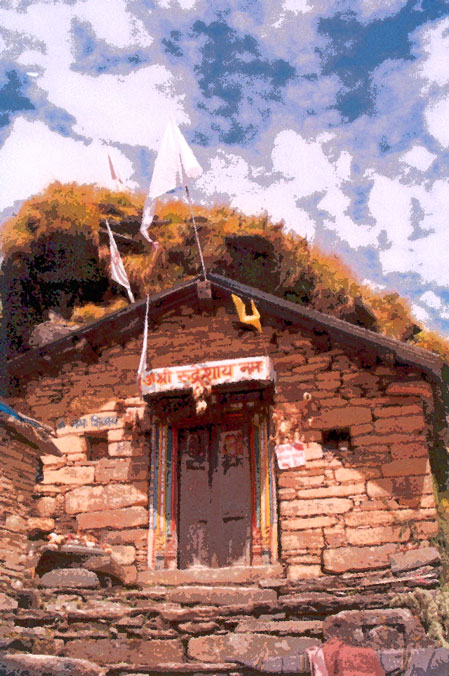 Rudranath Temple The night puja was going on. The Squadron Leader and a few of his men were attending it. We went straight in even though my upbringing normally forbade me to enter a temple without having a bath. However I figured that Rudranath would forgive me for having waved such formalities. My feet were getting really frozen, standing on the bare granite floor of the ancient shrine that had no pretences to any embellishments. In fact it was a cave set deep in the rock. The lingam was covered with a silver face, which had quite a fierce aspect. It was only the next morning when the mask was removed that I saw the actual lingam, with Shiva’s face. It was benign and beautiful with half closed eyes. 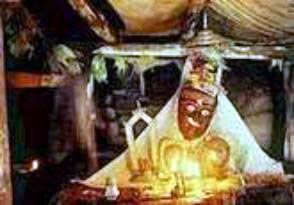 Rudranath Temple After the arati we approached the pujari and asked him if he could tell us where we could spend the night. He was a dour, old man and obviously his solitary stay in such a holy spot had not softened him. In fact it had made him rough and rude quite unlike the other priests we had met at the other shrines. He was most unwelcoming and told us that the only accommodation was a shepherd’s hut, which we could use if we liked. Since there was not much option we went there only to be met with a cloud of smoke when we opened the wooden door. We couldn’t make out much in the beginning but as our eyes got accustomed to the smoke we saw that it was a small granite hut with a fire in the middle. It was already crowded with four shepherds who were adding their bit to the general atmosphere with smoke from their beedies (country cigarettes)! However beggars can’t be choosers so since I was the only woman, they were kind enough to give me a corner in which I laid my sleeping bag and was flanked on the sides by my son and brother. We went out for a small bit of fresh air and our nostrils were assailed by the smell of delicious cooking which was coming from the impromptu kitchen which had been set up by the Squadron. Of course they had their own tents for sleeping. We joined them for a delicious meal. Just imagine the fare that the Lord had provided for us on top of this solitary mountain where we would surely have had to starve had these people not been there. It was very doubtful if the surly pujari would have offered us a meal. After this we retired to our sleeping quarters. Of course I must admit that due to the bitter cold, the smoke and the bad odour, I didn’t manage to sleep much.  Nandi Devi (7816 meters) When I went out in the morning all my pains and aches vanished with the breathtaking sight that met my eyes. The soaring peaks of Trishul and Nanda Devi could be seen unbelievably close and the purple rhododendrons could be admired in all their glory. The peaks were touched with gold as the sun slowly rose. Temple bells were ringing so I ran to the shrine to see the Lord’s face without the mask and watched the abhishekam or ritual bath. This time I was all alone with the pujari who didn’t even deign to glance at me. However I was least bothered. My heart was bursting with gratitude for the grace, which had allowed a person like me who was most un-equipped for such things to come and have darshan. Tears streamed down my eyes and all I could do was to fall down in full prostrations and thank Him again and again. I was sorely tempted to stay a couple of days as we had planned to do and go and see the Surya Kund, Chandra Kund, Tara Kund and Manasa Kund. The Vaitarani River is also here. This is the river that has to be crossed by the departing souls before they enter the next world. So some hardy people do come here to do rites for their departed ancestors. Both my son and brother were very anxious to leave as fast as possible since they didn’t fancy spending another day in the shepherd’s hut and least of all did they fancy having anything to do with the unfriendly pujari. Added to this was the fact that our source of sustenance (the squadron), was leaving for their next destination, which was Tunganath. So I had to comply with their wishes. We took a fond farewell of the peaks and the shrine and started our downward trek.  Trishul It was an incredibly long and tiring trek to Mandal where we were told we would find a PWD rest house. The journey took us through rugged tracks and dense forests. We had an occasional glimpse of a flock of deer gambolling in the distance and always the deep silence with the sound of gurgling rivulets somewhere in the distance. We managed to reach the rest house as the shades of night were falling and fell into the hard beds which seemed soft as down after our experiences of the past few days. It is indeed strange how the body demands its comforts even when the mind is saturated with beauty and abundance. The return to civilization was a kind of drop from the heights of ecstasy to which we had been taken. I always feel like crying when I reach the plains and my heart yearns to make another trip to the inaccessible peaks of the Himalayas with their unbelievably holy atmosphere. Who were these ancestors of ours who had discovered these spots? How did they reach there and who were the people who continued to keep up the tradition through the centuries and conduct the daily pujas of these lonely shrines is a mystery which has always fascinated me. The comfort of a soft bed and the prospect of a delicious meal were never enough to tempt me to return to a mundane life.  |
|||||||||||
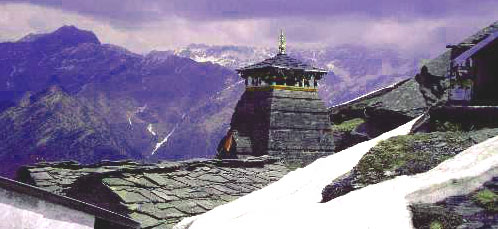 Tungnath Panch kedar trek Badrinath & the Valley of Flowers Kuari Pass Khero Valley Chenap Bughyal 7 others... Nanda Devi Sanctuary Nanda Devi Classic Roopkund and others... Cradled in the Garhwal Himalaya's ranges are five of Hinduism's most important temples inspired by the five religious forms of Lord Shiva, known as the Panch Kedar. The Panch Kedar trek includes all the shrines associated with these legends. Kedarnath is situated at the head of the Mandakini River, where the Linga is a natural rock that resembles the hump of a bull. Madhmaheshwar, at the base of the Chaukhamba Peak, is at the altitude of 3500 m. The Linga is here worshipped in the form of a navel. 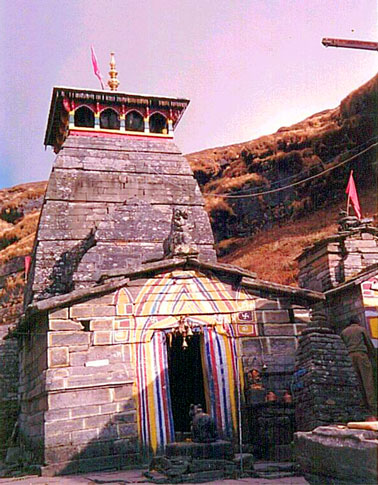 Tungnath Tungnath, where the arm of Shiva appeared, is the highest temple in Garhwal (3810 m). 500 m above the temple at Tungnath is Chandrashila, with a breathtaking view of the Himalayas. Rudranath is situated where the face of Shiva is said to have appeared. There is a natural rock temple in which the Shiva Mukha is worshipped. Nearby the temple, there are many little lakes like the Surya Kund, Tara Kund and Manas Kund. Kalpeshwar is situated in the beautiful valley of Urgam. There is a cave temple and Shiva is worshipped in his matted hair form, when He tried to flee from the Pandavas at Kedarnath. 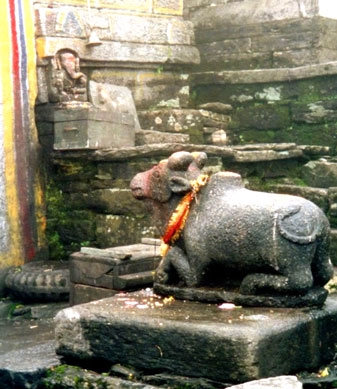 Trek route / Best time: June to October / 170 km circuit / 13 days (moderate). Rishikesh – Kedarnath – Madmaheshwar – Tungnath –Rudranath – Kalpeshwar - Joshimath. It is a trek through dense forest and lush meadows full of colours, passing through a few rustic villages steeped in old culture. 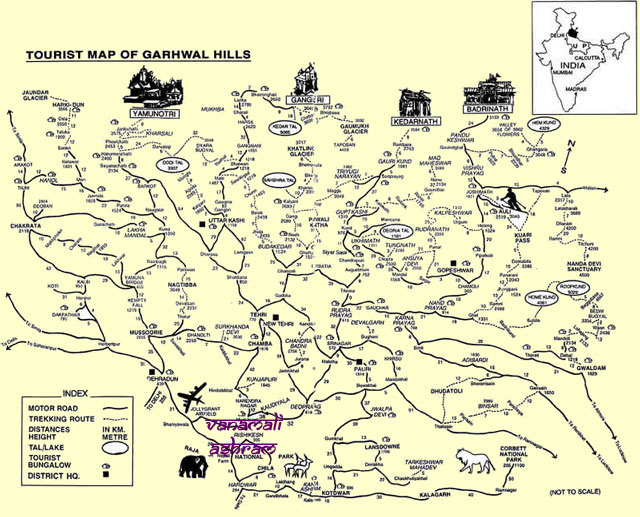 ... One can also trek to the temples dedicated to Vishnu, the Dhayan Badri and Bansi Narayan ones. But they are not in this Panch Kedar Circuit. They have more local importance...  Valley of Flowers |
|||||||||||
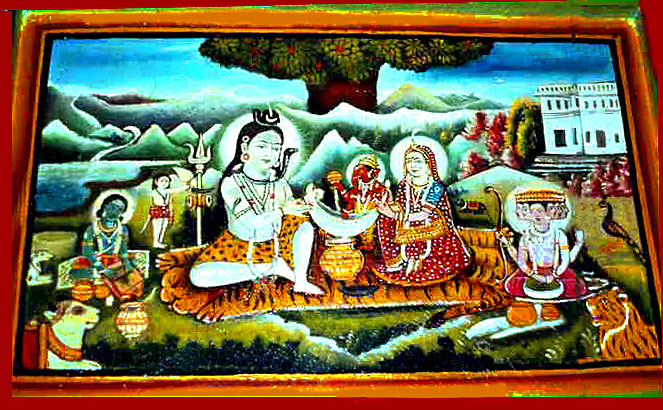 Namashivaaya! |
|||||||||||
| To be continued: | |||||||||||

|
|||||||||||
|
|||||||||||
